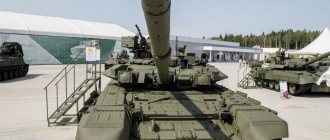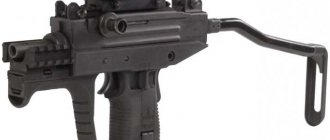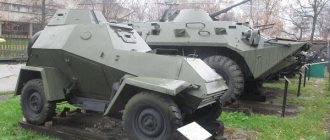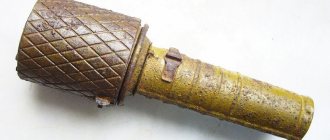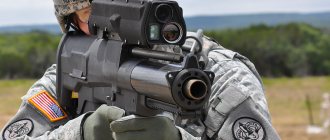F-1 anti-personnel defensive hand grenade
F1
(GRAU index - 57-G-721) - hand-held anti-personnel defensive grenade. Designed to defeat manpower in defensive combat. Due to the significant radius of scattering of fragments, it can only be thrown from behind cover, from an armored personnel carrier or from a tank.
The names “F-1” and the slang “lemon” came from the French fragmentation grenade F-1 model 1915 weighing 572 g and the English Lemon system grenade, which were supplied to Russia during the First World War. Another possible origin of the slang name is its shape, which resembles a lemon.
Initially, F-1 grenades were equipped with F.V. Koveshnikov's fuse. In 1941, E.M. Viceni and A.A. Bednyakov developed a universal UZRG fuse; after the war it was modified and serves to this day under the name UZRGM (modernized universal hand grenade fuse).
Story
Due to numerous technical shortcomings of the RGD-33 grenade, which was in service in the Soviet Union at that time, a decision was made to develop a reliable and technologically advanced defensive infantry grenade. The development of this device was entrusted to the designer F.I. Khrameev. In 1939, two months after receiving the technical specifications, he developed the F-1 grenade. According to the designer himself, the greatest difficulty for him when developing this grenade model was the selection of shell material and ensuring the reliability of the fuse.
Preliminary testing of this type of weapon was minimal; 10 prototypes were made, which were soon tested, and then the design was put into mass production. Here is what F.I. Khrameev himself said in an interview with journalists about this:
— Was some kind of selection committee created? - Not really! Again I'm alone. The head of the plant, Major Budkin, gave me a chaise and sent me to our training ground. I throw grenades one after another into the ravine. And on you - nine exploded, but one didn’t. I'm coming back and reporting. Budkin shouted at me: he left a secret sample unattended! I'm going back, alone again. — Was it scary? - Not without that. I lay down on the edge of the ravine and saw where the grenade lay in the clay. He took a long wire, made a loop at the end and carefully hooked it onto the grenade. Tugged. Didn't explode. It turned out that the fuse had failed. So he pulled it out, unloaded it, brought it, went to Budkin and put it on his table. He screamed and jumped out of the office like a bullet. And then we transferred the drawings to the Main Artillery Directorate (GAU), and the grenade was put into mass production. Without any experimental series.
The most common belief is that the F-1 grenade originated from an English grenade from the First World War, known in Russia as the Mils grenade. For those times it was the most destructive grenade. They are similar in shape and principle of the fuse. F. Leonidov in the magazine “Weapons” (No. 8, 1999) in the article “Prepare grenades” states that the basis for the development of the F-1 was the French F-1 model of 1915 and the English Lemon system. It was not possible to establish whether this is so.
Khrameev, in an interview with Kommersant magazine, acknowledged the origin of the grenade from the French F-1 model. Below is an excerpt from this interview.
In February 1939, I received an assignment to develop a defensive grenade... in Moscow I saw an album released by the Russian General Staff in 1916, which presented images of all the grenades used in the First World War. German and French were corrugated, egg-shaped. I especially liked the French F-1. It exactly corresponded to the task received: easy to throw, safe fuse, sufficient number of fragments. The album contained only a drawing. I developed all working drawings. I had to suffer. I replaced the plain cast iron from which the F-1 was made with steel to increase the destructive power of fragments.
British analogues of "lemon" - Mils grenades
This version is also confirmed by a comparative analysis of the design of the French F-1 grenade, the English Lemon system grenade and the modern F-1 grenade. Structurally, the early versions of the F-1 are virtually identical to the French counterpart, and the only differences are in the mass of the grenade, the design of the fuse and the material of the metal shell. The relative position of the nodes and the shape of the grenades are identical. The Lemon grenade has a spherical or, in a later version, ovoid shape, without a finned shell, and with a slightly different location of the fuse in the grenade body. It is believed that the Lemon grenade of the 1906/1913 model, which is indeed somewhat similar to the F-1, was created precisely under the influence of the French F-1 grenade. Also, the connection between the origin of the Soviet grenade and the French F-1 is confirmed in the training manual of the Red Army Artillery Academy, published in 1943 under the title “Hand Grenades”.
Shown is a French hand grenade F-1 mod. 1915, weighing 550g... The F-1 grenade has been used in the USSR since 1926 with a Kaveshnikov fuse, which provides more reliable action, safety when throwing and ease of handling.
This is another confirmation of the version about the origin of the Soviet grenade from the French F-1.
When the F-1 grenade was created, it had a Kaveshnikov fuse, then it was replaced by a standard unified UZRG fuse; after the end of the Great Patriotic War, the fuse was improved, the reliability of operation was increased, and it received the designation UZRGM.
Design
The F-1 grenade has the following tactical and technical characteristics.
- Throwing range: 35-40 m
- Shrapnel damage radius: 30 m (most likely the enemy will be hit by shrapnel), 200 m (maximum flight range of shrapnel)
- Fuse deceleration time: 3.2-4.5 sec
- Number of fragments up to 300 pcs.
The F-1 grenade is a hand-held anti-personnel, long-range defensive fragmentation grenade. Its design turned out to be so successful that it has existed to this day without fundamental changes. The design of the fuse was slightly changed and modified in order to increase operational reliability.
- Manual - delivered to the target by throwing the soldier’s hand.
- Anti-personnel - designed to destroy enemy personnel.
- Fragmentation - damage is caused mainly by fragments of the metal body of the grenade.
- Defensive - the radius of scattering of fragments exceeds the average range of throwing a grenade using the muscle strength of a fighter, which necessitates the need to throw a grenade from cover in order to avoid being hit by fragments of one’s own grenade.
- Remote action - the grenade detonates some time after the throw (from 3.2 to 4.2 seconds).
Like most anti-personnel grenades, the F-1 consists of 3 main parts.
- Fuse. The grenade has a universal fuse UZRGM (or UZRG), which is also suitable for RG-41, RG-42, RGD-5 grenades. The UZRGM fuse differs from the UZRG by changes in the shape of the trigger guard and the design of the striker, which made it possible to reduce the frequency of weapon failures.
- Explosive. The explosive charge is 60 g of TNT.
- Metal shell. Externally, the grenade has an oval ribbed body made of steel cast iron. Initially, the fins were created to produce fragments of a certain size and mass during an explosion; the fins also perform an ergonomic function, facilitating better retention of the grenade in the hand. Subsequently, some researchers expressed doubts about the effectiveness of such a system for forming fragments. The total weight of the grenade with fuse is 600 g.
The composition of the UZRG fuse includes, in addition to the body itself, the following elements:
- A safety pin, which is a ring with two pieces of wire, which, passing through the holes in the fuse body, are secured by extension in the hole on the opposite side of the fuse and protect the pin from accidental falling out. In this case, the pin blocks the firing pin, preventing it from hitting the detonator capsule.
- The firing pin is a metal rod, sharpened on the side directed towards the capsule, and having a protrusion on the opposite side, with which it holds the trigger guard. Also, a shock spring is attached to the firing pin, ensuring its impact on the primer.
- The trigger guard is a curved metal plate that, after removing the safety pin, locks the firing pin in its original position. After the grenade is thrown, the trigger guard is pushed out by the pressure of the firing pin spring, which hits the primer, activating it.
- The capsule ignites the retarding fuse, which, after burning for some time, directly activates the detonating mixture - the grenade is detonated.
- The delay fuse creates a time interval between the throwing and detonation of the grenade.
- The detonating mixture detonates the grenade's explosives.
Usage
To use a grenade, you need to straighten the antennae of the safety pin, take the grenade in your right hand so that your fingers press the lever to the body. Before throwing a grenade, insert the index finger of your left hand into the pin ring and pull it out. The grenade can continue to remain in the hand for as long as desired, since until the lever is released, the firing pin cannot break the primer. After choosing the moment of the throw and the target, throw a grenade at the target. At this moment, the lever will rotate under the influence of the striker spring, releasing the striker, and fly off to the side. The drummer will puncture the capsule and after 3.2 - 4.2 seconds an explosion will occur. Defensive type - means that the grenade fragments have a fairly large mass and fly to a distance exceeding the possible throw range (that is, when the grenade explodes, it is dangerous for the soldier who threw it, if he did not take cover in a trench, behind a wall, etc.) .
The grenade is designed to destroy manpower and unarmored vehicles.
The damaging factors are the direct high-explosive action of the explosive and the fragments formed when the metal shell of the grenade is destroyed. Marking and storage
The combat grenade is painted green (khaki to dark green). The training and simulation grenade is painted black with two white (vertical and horizontal) stripes. In addition, it has a hole at the bottom. The fighting fuse has no color. In the training-imitation fuse, the pin ring and the lower part of the pressure lever are painted scarlet.
F-1 grenades are packed in wooden boxes of 20 pieces. UZRGM fuses are stored in the same box separately in two metal hermetically sealed jars (10 pieces per jar). The weight of the box is 20 kg. The box is equipped with a can opener designed to open a can of fuses. Grenades are equipped with fuses immediately before the battle; when transferred from the combat position, the fuse is removed from the grenade and stored separately.
The purpose of packaging fuses in sealed containers is to ensure maximum safety during the entire storage period, to prevent corrosion and oxidation of the components of the detonating mixture.
Combat use
Tactical features of combat use
In open areas, the effective range of destruction of the enemy when a grenade explodes directly with the high-explosive action of ammunition is 3-5 meters. At a distance of up to 30 meters, the further the enemy is from the center of the explosion, the lower the chances of him being successfully hit by shrapnel. The chances of injury from grenade fragments remain at a distance of up to 70-100 meters, but this statement is true only for large fragments of the shell. The larger the fragment, the higher its potential damage range. The initial speed of grenade fragments is 700-720 meters per second, the average mass is 1-2 grams, although both larger and smaller ones are found.
The characteristics of the damaging factors of grenades naturally determine the areas of application in modern conflicts. Grenades have the greatest effect indoors and confined spaces. This is due to the following factors. Firstly, in a relatively small room, up to 30 meters in size, the entire space is in the destruction zone of fragments, and fragments can also ricochet off the walls of the ceiling and floor, which again increases the chances of hitting the enemy, even if he is in cover. Secondly, the high-explosive effect of a grenade in a closed room is multiplied many times over, causing concussion, barotrauma, disorienting the enemy, which allows one to take advantage of the moment to enter the room and use other weapons to destroy it.
The F-1 grenade is more effective compared to offensive grenades when storming confined spaces and premises; due to its higher mass, it produces more fragments and has a more pronounced high-explosive effect, all this makes it more likely to incapacitate the enemy.
Tactical features of sabotage use
Also, F-1 grenades are often used when setting tripwires, this is due to the number of fragments, which increases the chances of hitting the enemy, and a reliable fuse, which will not be damaged by prolonged exposure to unfavorable conditions before the trap is triggered.
Application in military conflicts
At the beginning of World War II, grenade bodies were filled with explosives available instead of TNT; Searchers find grenades filled with black powder in the Leningrad area. A grenade with this filling is quite effective, although less reliable.
During the Great Patriotic War, the F-1 was widely used on all fronts.
In the late 30s and early 40s of the 20th century, tactical instructions for infantry units recommended the F-1, including as an anti-tank weapon. Several grenades were tightly tied into a bag so that the detonator of one of them remained outside, the bag was thrown under the tracks or wheels of enemy armored vehicles in order to disable the chassis. Subsequently, this method was not widely used due to its relatively low efficiency.
Advantages Thanks to its simple and reliable design, the F-1 grenade has been in service for about 70 years without significant changes and will probably not be removed from service for a long time. The advantages that ensure such a long service life are as follows:
A body of natural crushing, from which destructive elements are successfully formed even when the metal jacket is damaged.
The remote igniter has a relatively simple design and is highly reliable.
The all-metal housing is easy to manufacture and can be manufactured in virtually any industrial facility. The simplicity of the internal design allows, in war conditions, to use any available explosive instead of standard TNT.
Disadvantages The disadvantages of this grenade are mainly due to the obsolescence of its design, and not to design flaws. These include:
The corrugation of the body cannot always ensure uniform formation of fragments. The remote fuse does not lead to an explosion when it hits the target, but goes off after some time. The grenade is relatively heavy, which somewhat reduces the maximum throwing range.
| Type: | anti-personnel hand grenade |
| A country: | USSR |
| Characteristics | |
| Weight, kg: | 0,6 |
| Length, mm: | 117 |
| Diameter, mm: | 55 |
| Explosive: | TNT |
| Mass of explosive, kg: | 0,06 |
Dear readers! Subscribe to us on Twitter, Vkontakte, Odnoklassniki or Facebook.
Content
- 1. History
- 2 Construction
- 3 Use
- 4 Labeling and storage
- 5 Combat use 5.1 Tactical features of combat use
- 5.2 Tactical features of sabotage use
- 5.3 Application in military conflicts
- 5.4 In service
- 8.1 Advantages
Literature[ | ]
- Shunkov V.N.
Infantry weapons 1939-1945. - Minsk: Harvest, 1999. - 624 p. — ISBN 985-433-803-7. - Description of the F.1 hand grenade with a Koveshnikov fuse.. - M.: Publication of the Artillery Directorate of the Red Army., 1931. - 16 p.
- A. A. Blagonravov, M. V. Gurevich.
Small arms ammunition. Cartridges, hand and rifle grenades. Their structure.. - L.: Publication of the Military-Technical Academy of the Red Army named after Comrade. Dzerzhinsky., 1932. - 210 p. — 1000 copies.
- A brief description of the design and use of hand grenades of the F-1 brand with a fuse of the F.V. Koveshnikov system.. - M.: Artillery Directorate of the Red Army., 1937. - 6 p.
- B.V. Pribylov, E.N. Kravchenko.
Hand and rifle grenades.. - M.: "Arctic 4D", 2008. - 776 p. — 3000 copies. — ISBN 978-5-902835-04-2.
- Manual on shooting (NSD-38). Hand grenades.. - M.: State military publishing house of the People's Commissariat of Defense of the USSR., 1939. - 47 p.
- Shooting manual. Hand grenades. / Under the supervision of D. I. Kozlov. - M.: Military Publishing House of the USSR Ministry of Defense., 1965. - 65 p.
Project evaluation[ | ]
In general, this example of an anti-personnel grenade should be considered successful. The F-1 has stood the test of time, has a simple, reliable design, is technologically advanced and easy to manufacture, and effectively copes with the tasks assigned to this type of weapon. It is natural that the shortcomings of the project flow from its advantages.
Advantages[ | ]
Due to its simple and reliable design, the F-1 grenade has been in service for about 70 years without significant changes and will probably not be removed from service for a long time. The advantages that ensure such a long service life are the following[18]:
- A body of natural crushing, from which destructive elements are successfully formed even when the metal jacket is damaged.
- The remote igniter has a relatively simple design and is highly reliable.
- The all-metal monolithic body is easy to manufacture and can be manufactured at almost any industrial enterprise, even non-specialized ones. The body material - steel cast iron - is very cheap.
- The simplicity of the internal design allows, in war conditions, to use any available explosive instead of standard TNT.
- The power of the explosion of this grenade is such that, when thrown into a well, it literally “throws out” all the objects in it, including water. This property is useful when storming various mines and tunnels of medium diameter. If the enemy hiding behind a turn, corner or other obstacle at a distance closer than 30 meters from the explosion is not hit by shrapnel, then he is almost guaranteed to be killed by a sharp pneumatic shock caused by the blast wave[19]. The attacker is prohibited from being in the tunnel, as he himself may get hurt.
- The remote detonation action allows you to throw a grenade towards the enemy, using the rebound from walls, ceilings and various obstacles.
Disadvantages[ | ]
The disadvantages of this grenade are mainly due to the obsolescence of its design, and not to design flaws. These include:[18]
- Low efficiency of formation of fragments when crushing the body. Most of the body mass (up to 60%) forms fragments that are too small to kill. At the same time, several too large fragments are often formed, increasing the dangerous distance and reducing the number of fragments of the optimal size. The corrugation of the hull, which is generally random in nature, cannot ensure the formation of fragments of a satisfactory shape and their optimal distribution over the mass (the very idea of the formation of fragments of a predictable size due to the corrugation of the hull turned out to be not entirely correct).
- The remote fuse does not lead to an explosion when it hits the target, but fires after some time (this is a property of any
remote fuse, not just the UZRG). - The grenade is relatively heavy, which somewhat reduces the maximum throw range.
Using[ | ]
To use a grenade, you need to straighten the antennae of the safety pin, take the grenade in your right hand so that your fingers press the lever to the body. Before throwing a grenade, insert the index finger of your left hand into the pin ring and pull it out. Experienced instructors claim that a left-handed person can hold and throw a grenade with his left without any problems, and pull the pin with his right. The grenade can continue to remain in the hand for as long as desired until the lever is released, the firing pin cannot break the primer (in principle, if the need to throw a grenade has disappeared and the pin has not been thrown out, it can be inserted back (without releasing the lever!); after bending tendrils of pomegranate checks are suitable for normal storage). [ source not specified 954 days
] After choosing the moment of the throw and the target, throw a grenade at the target. At this moment, the lever will rotate under the influence of the striker spring, releasing the striker, and fly off to the side. The drummer will puncture the capsule and after 3.2 - 4.2 seconds an explosion will occur.
The grenade is designed to destroy manpower and unarmored vehicles. The damaging factors are the direct high-explosive effect of the explosive and fragments formed during the destruction of the metal shell of the grenade [10] [14].
Cons of lemons
Firstly, weight. As much as 0.6 kg! In combat conditions this is a very significant mass. Secondly, “blurred” fuse action: from 3.2 to 4.2 s. Moreover, in practice there are constantly samples that can explode in both a shorter and longer time. In one part of Transbaikalia, this circumstance almost led to tragedy when a grenade exploded after eight seconds!
At that time, the soldier had already leaned out from behind the cover, and only by a lucky coincidence he was not chopped into shrapnel. In addition, in combat conditions, the prolonged action of the fuse can lead to the fact that a particularly “nimble” enemy will simply throw away the “gift” that has flown to him.
Thirdly, there is no grenade option that would explode immediately after contact with the target. These are the so-called mountain models. In Afghanistan, this has repeatedly led to tragedies when a thrown projectile bounced off a rock and flew back. All these shortcomings were absent in the RGO and RGN grenades. But they were much more expensive and more difficult to produce, and their release occurred during the collapse of the USSR. So the same “efka” remained on guard.
The F1 lemon grenade, having many positive qualities, will in any case be in service with our army for many years to come.
About the history of creation. How did it all begin?
In 1922, by order of the military leadership of the Red Army, an audit of artillery ammunition warehouses was carried out. At that time, the Red Army had seventeen types of grenades. Nevertheless, among the large assortment of defensive fragmentation models, there were no domestically produced products. The Red Army soldiers used grenades made according to the Mills system. At least 200 thousand units of such hand-held projectiles were stored in warehouses. French ammunition was also used - the 1915 F-1. However, this “pocket shell” had a very unreliable fuse. Since the cardboard case was not airtight enough, the detonation composition became damp, as a result of which French grenades often did not work or exploded in the hands of soldiers. The report to the military department of the Red Army indicated that the Soviet army was only 0.5% equipped with explosive devices of fragmentation-defensive type. In 1925, all explosive devices available in artillery depots were tested. The task of the expert commission was to choose the best option, which could later be used to design a Soviet grenade. After testing, the choice fell on the explosive devices of the 1914 Mills system and the F-1.
Notes[ | ]
- The Global Intelligence Files — Re: SITREP — INSIGHT — LEBANON — update on black market prices
- Vernidub I. I.
Hand grenades - “pocket” infantry artillery // Victory Ammunition. Essays. - Moscow: TsNIINTIKPK, 1998. - P. 95. - 200 p. - Shooting manual. Hand grenades. - M.: Military Publishing House of the USSR Ministry of Defense. 1965 - 65, p.15
- ↑ 12345
B.V. Pribylov, E.N. Kravchenko. Hand and rifle grenades. - M.: "Arctic 4D", 2008. - 776 - A brief description of the design and use of hand grenades of the F-1 brand with the fuse of the F.V. Koveshnikov system. Artillery Directorate of the Red Army. M. 1937
- A. A. Blagonravov, M. V. Gurevich. Small arms ammunition. Cartridges, hand and rifle grenades. Their device. L.: Publication of the Military-Technical Academy of the Red Army named after Comrade. Dzerzhinsky, 1932, p. 159
- ↑ 12
Fedoseev S. L. Throwing shells of the Soviet infantry. Military industrial courier. Issue No. 39 (355) October 6, 2010 - ↑ 12
Kommersant Power magazine. No. 47(348) dated November 30, 1999 - Very often, when describing this type of ammunition, a distance of 200 m is indicated. Theoretically, grenade fragments can fly to such a distance, but the probability of these fragments hitting the target tends to zero. Most likely, a distance of 200 m refers to the distance at which the observer must be in order to avoid being injured under any circumstances. In reality, we can talk about a more or less guaranteed defeat of a standing person at a distance of no more than 5-10 meters. At distances greater than 50 m, human damage is extremely unlikely
- ↑ 123456789
Anatomy of an army. Veremeev Yu. Soviet defensive grenade F-1 - Anti-personnel hand grenade F-1
- Fragments weighing at least 2 grams are considered dangerous. Fragments of smaller mass, even at high speed, are not able to cause any significant damage. Thus, theoretically, one grenade weighing 540 g (explosive charge weight 60 g) under ideal conditions can produce up to 270 fragments with a lethal effect. In reality, the number and mass of fragments fluctuate within very wide limits, and the number of lethal fragments does not exceed 150-200. If a grenade explodes on the ground, the number of lethal fragments is reduced by approximately half, since fragments going into the lower hemisphere do not pose a danger
- ↑ 1234
LCI. Hand grenades. - ↑ 1234
Anatomy of an army. Veremeev Yu. Pomegranate Arithmetic - Magazine "Weapons" No. 8, 1999, article "Prepare grenades"
- Magazine "Brother". Grenade for military reconnaissance (unspecified)
(inaccessible link). Retrieved May 27, 2009. Archived September 6, 2009. - WWII-60. RPG-40 - hand-held anti-tank grenade system. Puzyreva (inaccessible link)
- ↑ 12
Grenade F-1 Archived February 24, 2007. - What are the specifics of the subway explosion?

